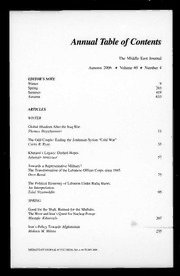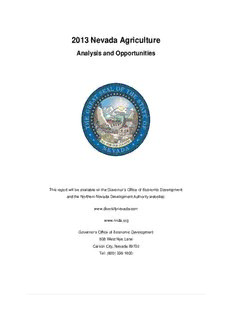
2013 Nevada Agriculture Analysis - Nevada Department of Agriculture PDF
Preview 2013 Nevada Agriculture Analysis - Nevada Department of Agriculture
2013 Nevada Agriculture Analysis and Opportunities This report will be available on the Governor’s Office of Economic Development and the Northern Nevada Development Authority websites: www.diversifynevada.com www.nnda.org Governor’s Office of Economic Development 808 West Nye Lane Carson City, Nevada 89703 Tel: (800) 336-1600 “I have always said there is only one thing that can bring our nation down - our dependence on foreign countries for food and energy. Agriculture is the backbone of our economy.” John Salazar ACKNOWLEDGEMENTS This report was prepared by the Northern Nevada Development Authority and the Business Resource Innovation Center, the business branch of Carson City Library, for the Governor’s Office of Economic Development. Support for this report was provided by the members of the Agriculture Committee of the Northern Nevada Development Authority. Special thanks to Lynn Hettrick, Jim Barbee, Al DiStefano, Sarah Adler, University of Nevada Cooperative Extension Program, Doug Taylor, and Ann Louhela for providing valuable information and industry insight. Thanks to Eugenia Larmore of Ekay Economic Consultants for her expertise, resources, and economic development and impact analysis report that added to the foundation of this study. Thanks to the NNDA staff for their tireless efforts in getting this report ready for publication. Table of Contents EXECUTIVE SUMMARY ……………………………………………………………………………… 1 AGRICULTURE IN NEVADA .………………………………………………………………………. 4 Nevada Agriculture Survey 5 Examples of existing agriculture success 8 Economic analysis of agriculture sector 12 Agriculture sector definition 12 Agriculture production industries 12 Agriculture support industries 13 Agriculture processing and packaging industries 14 Agriculture distribution industries 16 Agriculture sector performance 16 Comparison to US 20 Comparison to other Nevada sectors 20 Output per employee 21 Labor income per employee 24 Value of imports 27 Value of exports 28 Location quotient 29 Summary 32 AGRICULTURE CLUSTER ECONOMIC DEVELOPMENT ………………………………………. 33 Cluster value chains 33 Export enhancement 34 Directory of “Best Case” export 37 Import substitution 37 Imports by industry 41 Agriculture cluster economic impact analysis 44 Economic impacts of agriculture cluster output 46 Employment impacts of agriculture cluster output 47 FUTURE AGRICULTURE OPPORTUNITIES ……………………………………………………. 55 Hoop house or high tunnel 55 New crop opportunities 57 Saffron 58 What is a Rodale Test Garden? 59 Hops 59 Canola 60 Aquaculture farming 61 Talapia farms 61 Alternative crops 65 Perennial grasses 66 Teff (Tiffany Hay) 67 Expansion opportunities 69 Vertical farming and hydroponics 69 Wine Grapes / Vineyards 70 AGRICULTURE GAPS ………………………………………………………………………………… 74 Gap 1: Seed processing 75 Gap 2: Localized agriculture development 75 Gap 3: Dairy processing 79 Gap 4: Meat production 79 Gap 5: Agriculture equipment manufacturing 80 Gap 6: Agriculture marketing program 81 Gap 7: Federal loans, grants, incentives 82 USDA 82 Small Business Administration loans and grants 86 Industry constraints 86 Regulations 86 Taxes 87 RECOMMENDATIONS ………………………………………………………………………………… 89 RESEARCH ………………………………………………………………………………………….. 94 REFERENCES …………………………………………………………………………………………….96 APPENDICES …………………………………………………………………………………………. 102 “Nevada’s Agriculture Industry Sector is a major contributor to the overall economy of the state.” 1. EXECUTIVE SUMMARY Nevada’s Agriculture Industry Sector is a major contributor to the overall economy of the state. Its contribution has not been fully articulated nor understood by the general business and state government communities within Nevada. This study has been undertaken to examine the sector in an organized fashion and to identify gaps and targets for future economic development efforts. The study utilized primary and secondary research including interviews with industry stakeholders, surveys at all levels within the industry, and economic research and analysis to examine this critical industry. Findings of the study are summarized below: The overall economic impact of the agricultural cluster on the State of Nevada is estimated at $5.3 billion using 2010 data, including direct, indirect, and induced impacts. This impact varies by region; the study estimates impacts of the Northwestern, Northeastern, and Southern regions within the state. Nevada’s agriculture production has a significant impact on the state and varies by county. Some counties focus more on agricultural production, while others prefer agri-tourism and operation businesses, depending on the county’s strengths and assets. The location quotient analysis defines the agriculture production sector as Emerging, which indicates a sector that is not specialized compared to the nation, but growing in its specialization. The agriculture industry has numerous backward and forward linkages, including Wholesale Trade, Truck Transportation, Food Services, Hotels and Motels, and Real Estate. This means that logistic channels between these suppliers and customers are well established, which may make the state more attractive to businesses operating within these industries. The agriculture cluster has a number of gaps and disconnects, resulting in local businesses importing goods and services from outside of the area, which is the first step of import substitution, a practice of reducing the purchases of goods and services by local firms from outside of the state. The study shows a number of new crop opportunities given Nevada’s physical and economic strengths, including saffron, hops, canola, and aquaculture. Expanded agricultural opportunities for the state include vertical farming, wine grapes and vineyards, potatoes, onions and alfalfa. The agriculture cluster also has a number of industries exporting large amounts of goods and services outside of the area. For a successful export substitution effort, these businesses should be encouraged to increase exports and new exporters should be identified and developed . 1 | P a g e The employment impact of the agriculture cluster on the State of Nevada, using 2010 data, is estimated at 60,700 jobs, including direct, indirect, and induced impacts. The impacts of the Northwestern, Northeastern, and Southern regions are also estimated. Additionally, the study identified a number of gaps and resulting opportunities available for the Nevada agricultural sector, including the need for seed, dairy, and meat processing facilities as well as an agricultural equipment manufacturing facility. Agriculture, Forestry, Fishing and Hunting are emerging industries in Nevada, with a 7 percent growth from 2006-2011, showing industry growth and potential for future concentration. Overall, the agriculture cluster has a positive and significant impact on the state and is well positioned for future growth, given its potential for export enhancement and import substitution, though much work remains in identifying the factors necessary for successful growth. This includes understanding the reasons for import gaps and disconnects, identifying export ready companies, and supporting existing operators. 2 | P a g e “Nevada ranks third in the nation in ranch size, averaging 3,500 acres.” 3 | P a g e 2. AGRICULTURE IN NEVADA Overview Agriculture is one of Nevada’s most important industries, contributing significantly to the economies of rural communities and the state as a whole. Below is a summary of relevant facts regarding the agriculture industry in Nevada, and these facts are discussed in more detail throughout the report. Nevada’s ranches rank third in the nation in size, averaging 3,500 acres. Nevada agriculture is directed primarily toward range livestock production. Cattle and calves are Nevada’s leading agricultural industry, totaling $732,883,000 or 62.5 percent of the farm receipts (Nevada Department of Agriculture, 2011). “Over eighty percent of meat producers (including cattle, lamb, etc.) sell their meat as live animals on the hoof, while approximately ten percent sell their meat as carcasses” (Curtis, Cowee, & Havercamp, 2007). One reason for this is the limited number of meat processing facilities in the state, which is a potential growth area for the agriculture sector. Cow-Calf Operations are most prevalent with a few stocker operators and feedlots. Dairy, sheep, lambs, and hogs are among Nevada’s other livestock enterprises. The larger cattle and sheep ranches are in the northern half of the state. The greatest number of dairies is in northern Nevada, but the largest dairies are in the south. Despite Nevada’s arid climate, irrigation allows for excellent crop growth. Alfalfa hay is the leading cash crop of the state, totaling $232,100,000 (USDA, 2012). Much of the hay is sold to dairy operations in surrounding states. Significant quantities of alfalfa cubes and compressed bales are exported overseas each year. Alfalfa seed is another substantial crop. Additional crops produced in Nevada include potatoes, barley, winter and spring wheat, corn, oats, onions, garlic, and honey. Smaller acreages of mint, fruits and vegetables are grown throughout the state. The chart below shows the top five commodities in the state as determined by the Nevada Agriculture Statistics Bulletin, 2012 (USDA, National Agriculture Statistics Service, 2012). 4 | P a g e
Description:The list of books you might like

The Mountain Is You

Better Than the Movies

A Thousand Boy Kisses

Credence

Travel and Adventure in South-East Africa:
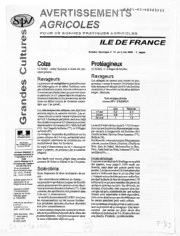
Avertissements Agricoles - Grandes cultures - Ile de France - 2006 - 14
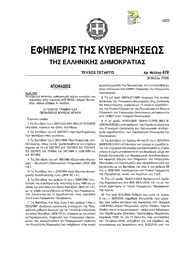
Greek Government Gazette: Part 4, 2006 no. 479
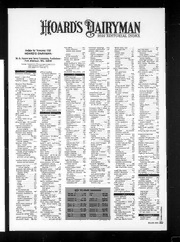
Hoard's Dairyman 2010: Vol 155 Index
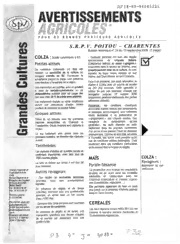
Avertissements Agricoles - Grandes cultures - Poitou Charentes - 2006 - 24

DTIC ADA520646: War Gaming: Space Perspective

Fundamentals of Risk Management: Understanding, Evaluating and Implementing Effective Enterprise Risk Management
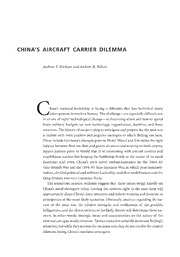
DTIC ADA519352: China's Aircraft Carrier Dilemma
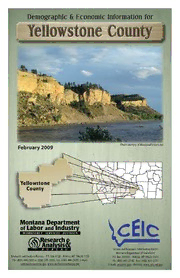
Demographic & economic information for Yellowstone County

Greek Government Gazette: Part 2, 2007 no. 1295

Greek Government Gazette: Part 2, 2006 no. 315

Bölüm-10-sunu
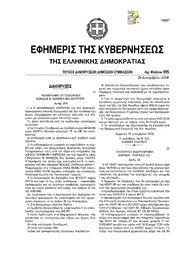
Greek Government Gazette: Part 7, 2006 no. 915

Quarterly Journal of Speech 2006: Vol 92 Index
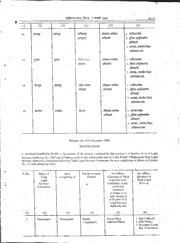
Chhattisgarh Gazette, 2006-01-17, EO Gazette 17, Notice न./844/1206/Sl.SA/Pl/05.-

Gardening Shortcuts
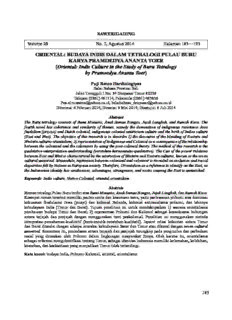
BUDAYA INDIS DALAM TETRALOGI PULAU BURU KARYA PRAMOEDYA ANANTA TOER ...

